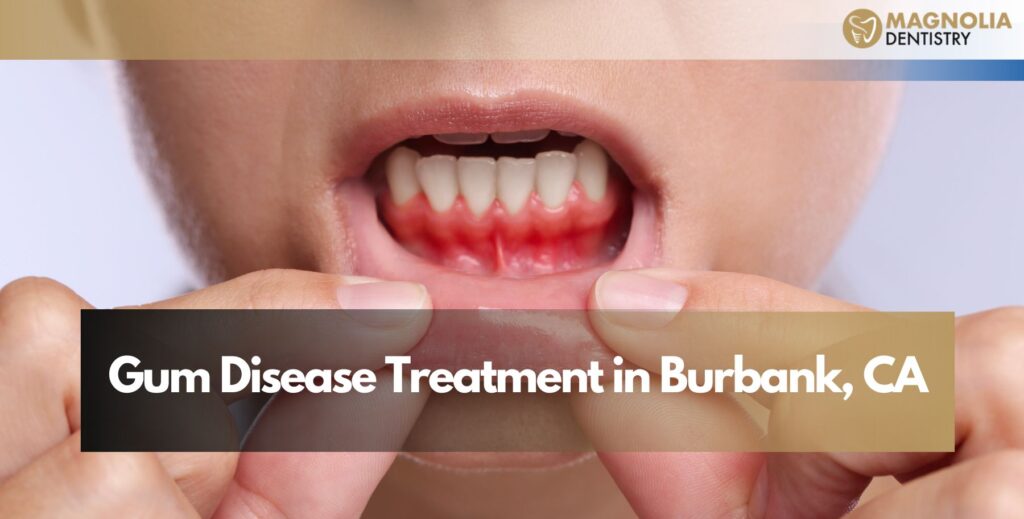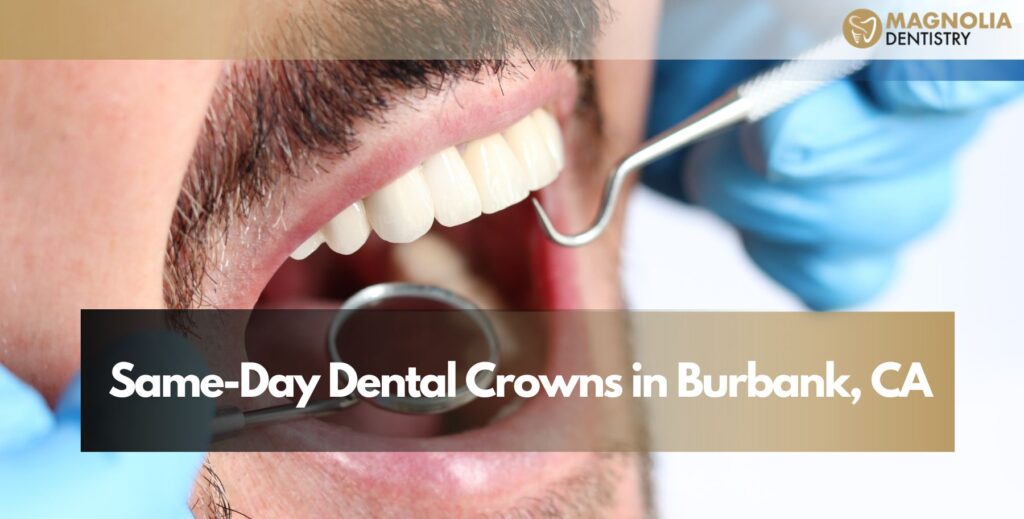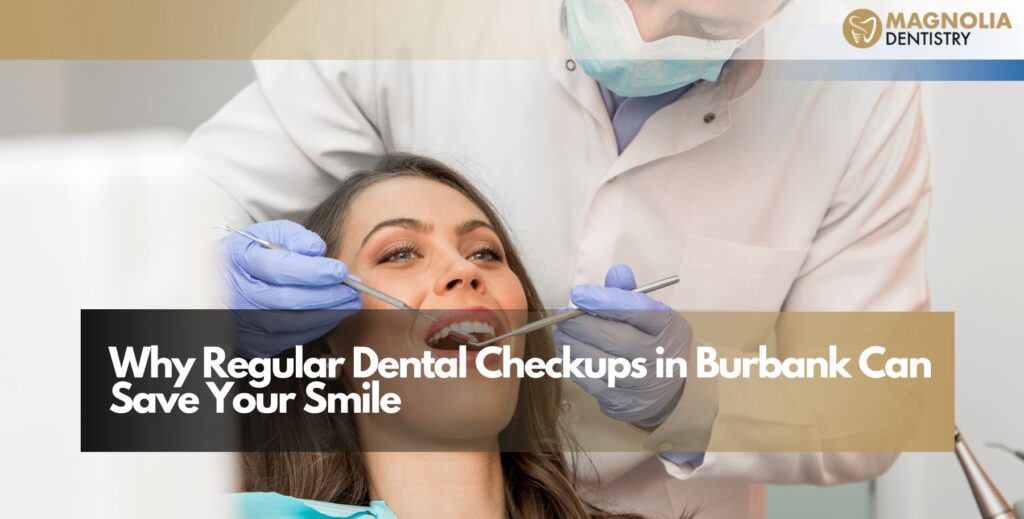Healthy gums are the foundation of a beautiful smile. When gums become infected or inflamed, your teeth and overall health can be at serious risk. Gum disease, also known as periodontal disease, is one of the most common oral health problems affecting adults in the U.S.—and it often develops silently.
At Magnolia Dentistry, we focus on early detection and advanced gum disease treatment in Burbank, CA, to help patients restore their oral health, prevent tooth loss, and enjoy a confident smile again.
Understanding Gum Disease
Gum disease is a bacterial infection that damages the tissues surrounding your teeth. It typically begins with mild inflammation called gingivitis and can progress to periodontitis if left untreated.
Plaque buildup is the main cause. When plaque hardens into tartar, bacteria release toxins that irritate the gums, causing them to pull away from the teeth and form pockets. Without treatment, these pockets deepen, leading to bone loss and loose teeth.
Common Signs and Symptoms
Recognising early warning signs is key to successful gum disease treatment. Look out for:
- Bleeding while brushing or flossing
- Swollen or tender gums
- Persistent bad breath
- Gum recession (teeth appearing longer)
- Loose or shifting teeth
- Pain while chewing
If you experience any of these symptoms, scheduling an appointment with a Burbank dentist right away can help prevent further damage.
Causes and Risk Factors
Gum disease develops due to a combination of poor oral hygiene and other health or lifestyle factors.
- Inconsistent brushing and flossing
- Smoking or tobacco use
- Poor nutrition
- Hormonal changes (pregnancy, menopause)
- Diabetes or immune disorders
- Family history of gum problems
Understanding these risk factors allows your dentist to customise your periodontal treatment plan effectively.
The Importance of Early Gum Disease Treatment
Early diagnosis makes a huge difference in outcome. Gingivitis—the first stage of gum disease—can be reversed with professional cleaning and improved home care. Once it progresses to periodontitis, treatment becomes more intensive and focuses on controlling infection and preserving remaining bone.
Regular dental visits are essential for catching gum issues early before they cause irreversible damage.
Types of Gum Disease
There are two primary stages of gum disease:
Gingivitis
This is the earliest stage, marked by redness, swelling, and bleeding gums. Gingivitis is completely reversible with proper dental cleaning, regular brushing, and flossing.
Periodontitis
When gingivitis isn’t treated, bacteria spread below the gum line. The infection destroys gum tissue and bone, forming deep pockets around teeth. At this stage, professional periodontal therapy, such as scaling and root planing, is required to stop progression.
Gum Disease Treatment Options in Burbank
At Magnolia Dentistry, we provide tailored treatment options for every stage of gum disease, from mild inflammation to advanced periodontal infection. Our focus is on preserving your natural teeth, improving oral health, and preventing further damage.
Professional Dental Cleaning
Routine professional cleanings remove plaque and tartar from above the gum line. This helps control bacteria and reduce inflammation in early-stage gingivitis. Regular checkups every six months are your first line of defence.
Scaling and Root Planing (Deep Cleaning)
Scaling and root planing is the most common non-surgical treatment for periodontitis. Scaling removes plaque and tartar from below the gum line, while root planing smooths the root surfaces to allow the gums to reattach.
This deep cleaning reduces bacterial buildup, tightens gum pockets, and helps restore gum health.
Antibacterial and Laser Therapy
In some cases, your dentist may apply antibacterial medications or use laser gum therapy to disinfect infected areas and promote faster healing.
Laser treatment is gentle, minimally invasive, and can reduce swelling and discomfort compared to traditional procedures.
Pocket Reduction Surgery (Flap Surgery)
When deep pockets persist after non-surgical treatment, flap surgery may be recommended. During this procedure, the gums are lifted to access and clean the tooth roots. The gums are then repositioned to reduce pocket depth, making it easier to keep them clean.
Bone Grafting and Regeneration
In severe cases of bone loss due to gum disease, bone grafts or regenerative procedures help rebuild lost bone and restore support to affected teeth.
Using biocompatible materials, your dentist can encourage new tissue growth and strengthen your smile’s foundation.
Gum Grafting for Recession
Gum grafting replaces lost gum tissue caused by recession. Tissue is taken from another area or a donor source and attached to the affected site to protect roots and improve appearance.
This not only enhances your smile but also protects against sensitivity and further gum loss.
Maintaining Gum Health After Treatment
Gum disease can be managed successfully with regular care and follow-ups. After your periodontal therapy, your dentist will recommend a maintenance plan to prevent recurrence.
Periodontal Maintenance Visits
Patients treated for gum disease typically need maintenance cleanings every 3–4 months instead of every six. These visits keep bacteria under control and monitor healing progress.
Proper Home Care Routine
- Brush twice daily using a soft-bristled toothbrush and fluoride toothpaste.
- Floss gently between teeth to remove trapped food and bacteria.
- Use an antimicrobial mouthwash to reduce plaque.
Consistent oral hygiene is the key to preventing gum problems from returning.
Healthy Diet and Lifestyle
Eat a balanced diet rich in vitamin C, calcium, and antioxidants. Avoid smoking and excessive alcohol consumption, as they delay healing and worsen gum conditions.
The Link Between Gum Health and Overall Wellness
Research shows that periodontal disease is linked to serious health conditions such as heart disease, diabetes, stroke, and respiratory infections. Inflammation in the mouth can affect the rest of your body.
By maintaining healthy gums, you reduce your risk of systemic health issues and improve your overall quality of life.
Why Choose Magnolia Dentistry for Gum Disease Treatment in Burbank
At Magnolia Dentistry, our team provides personalised gum disease treatment in Burbank, CA, using advanced technology, gentle techniques, and a compassionate approach. Whether you need preventive care, deep cleaning, or surgical treatment, we design your care plan to restore and protect your smile.
We focus not just on treating infection but on helping patients maintain lifelong gum health through education, ongoing care, and professional monitoring.
Conclusion
Gum disease is a serious but preventable condition. Early diagnosis and professional periodontal care can save your teeth, protect your gums, and improve your health. Don’t wait for discomfort or bleeding to get worse—schedule a visit today to restore your gum health and confidence.
Visit Magnolia Dentistry, Dentist in Burbank, CA, for expert gum disease evaluation and personalised treatment that keeps your smile strong and healthy.
FAQs
What causes gum disease the most?
Poor oral hygiene is the primary cause. Plaque buildup from not brushing and flossing regularly leads to bacterial infection and gum inflammation.
Is gum disease reversible?
Yes—early-stage gingivitis is reversible with professional cleaning and proper oral hygiene. Advanced periodontitis can’t be reversed, but can be controlled with ongoing treatment.
How do I know if I need gum disease treatment?
If your gums bleed when brushing, feel tender, or appear swollen or receding, you should visit your dentist for an evaluation.
Does scaling and root planing hurt?
No. Local anaesthesia is used to keep you comfortable. You may feel slight soreness afterwards, but it typically subsides within a day or two.
How long does gum disease treatment take?
Mild cases can be treated in one or two visits, while advanced cases may require multiple sessions and maintenance appointments.
Can gum disease cause tooth loss?
Yes. If untreated, gum disease destroys the bone and tissue supporting your teeth, leading to loosening and eventual loss.
Is gum disease contagious?
Bacteria can be transferred through saliva, but gum disease itself is a result of poor oral hygiene and individual immune response.
How can I prevent gum disease after treatment?
Brush twice daily, floss daily, visit your dentist regularly, and avoid tobacco use. A consistent routine helps prevent reinfection.
Can laser therapy treat gum disease?
Yes. Laser gum therapy is an advanced, minimally invasive treatment that removes infected tissue and bacteria while promoting faster healing.
Does insurance cover gum disease treatment?
Most dental insurance plans partially cover periodontal treatments like scaling, root planing, and maintenance visits.



